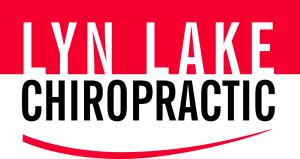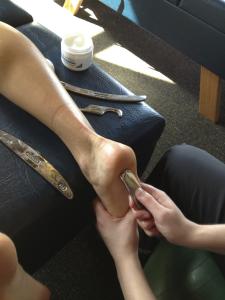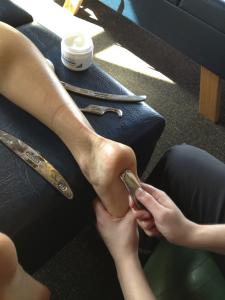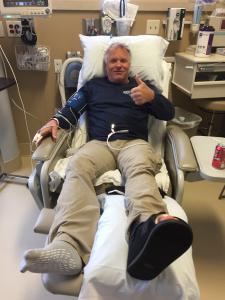Chiropractic Health & Wellness Blog
Minneapolis Chiropractic Care for Neck pain
 |
Minneapolis Chiropractic Care for Neck pain is a non-surgical treatment option that can help reduce your neck pain symptoms.
Some neck conditions that can improve with chiropractic care are:
- cervical intervertebral disc injuries that don’t require surgery
- cervical sprain injuries
- degenerative joint syndrome of the neck
- facet joint sprain
- Whiplash
How Does a Chiropractor Diagnose Neck Pain?
Your chiropractor will evaluate your spine as a whole because other regions of the spine may be affected as well—not just your neck. Along with treating the spine as a whole, Minneapolis chiropractors at Lyn Lake Chiropractic treat the “whole person,” not just your specific symptoms.
Before deciding which approach to try for your pain, the our chiropractor will do a thorough examination to diagnose the specific cause of your neck pain.
He will determine any areas of restricted movement and will look at how you walk as well as your overall posture and spinal alignment. Doing these things can help your chiropractor understand your Quick read more or view full article body mechanics.
In addition to the physical exam, you’ll also go through your past medical history with the chiropractor, and he or she may take x-rays or order imaging tests (eg, an x-ray or MRI) to help him or her diagnose the exact cause of your neck pain.
All these steps in the diagnostic process will give your chiropractor more information about your neck pain, which will help your chiropractor create a treatment plan customized for you.
Your chiropractor will also rule out a neck pain condition that will require surgery—if he or she believes your neck pain would be better treated by surgery, then you’ll be referred to a spine surgeon.
Chiropractic Treatments:
Your chiropractor may use a combination of spinal manipulation, manual therapy, and other techniques as part of your treatment plan for neck pain.
Below are some spinal manipulation techniques your chiropractor may use.
- Flexion-distraction technique is a gentle, hands-on spinal manipulation that involves a pumping action on the intervertebral disc instead of direct force.
- Instrument-assisted manipulation also known as Activator - a hand-held instrument to allow your chiropractor to apply force without thrusting into the spine.
- Specific spinal manipulation helps restore joint movement using a gentle thrusting technique.
Your chiropractor may also use manual therapies to treat your neck pain to help relax your muscles, relieve muscle spasm and hopefully relieve your pain.
- Graston or Active Release Techinque ( ART ) uses special instruments to diagnose and treat muscle tension which helps resore injured muscles, tendons and ligaments.
- Manual joint stretching and resistance techniques can help reduce neck pain and other symptoms.
- Therapeutic massage can help relax tense muscles.
- Trigger point therapy is used to reduce tight, painful points on a muscle.
Other therapies may also be used to ease neck pain symptoms.
- Inferential electrical stimulation uses a low frequency electrical current to stimulate neck muscles.
- Ultrasound sends sound waves into your muscle tissues to help stiffness and pain in your neck.
Therapeutic exercises may also be recommended—these can help improve overall range of motion in your neck and prevent neck pain from progressing.
The treatments listed above are simply examples of possible chiropractic treatments for neck pain; your actual treatment plan will depend on your diagnosis. Your chiropractor should thoroughly explain your treatment options so that you know what will happen. If you have any questions please always feel free to ask questions and ask you chiropractor doing the exam to explain what and why they are deciding on your treatment plan or options.
Most chiropractors are there to help people and enjoy making people feel better with working with your body. If needed medication and pain meds might be needed, conatct your medical doctor but for sure follow up with a chiropractor or P.T. to correct what is causing your pain.
If your reading this blog or posting and would like a Free Consulation at Lyn Lake Chiropractic please call anytime 612-879-8000. Or if you would like us to help refer you to a chiropractor in your area, call us we will help find you a chiropractor near your home.
Read LessTMJ Chiropractic Care
There are two temporomandibular joints (TMJ), one on each side of the face. They connect the jawbone to the skull and act like sliding hinges to open and close the mouth. They are important in chewing, talking, biting, singing, and making facial expressions.
The TMJ complex involves the jawbone, skull, tendons, ligaments, muscles and 2 discs. The discs are like cushions within each joint. The muscles around the TMJ include superficial muscles (close to the surface), and deep muscles (deep within the tissues), and they are collectively called the muscles of mastication.
Problems with the TMJ or the surrounding structures cause temporomandibular dysfunction. This
Quick read more or view full article
is often referred to as TMJ.
Causes
There are many causes of dysfunction. Any problem with the bones, joints, muscles or connective tissues around the joint can cause TMJ. Some of the more common causes include the following:
1) Injury- falling, car accidents, fights and any direct trauma to the area can cause damage to the joint and muscles.
2) Disc dislocation- the cushioning disc within the joint itself can become dislodged or stop gliding properly which can cause the joint to stop opening and closing properly.
3) Tight muscles- the muscles that attach the head to the jaw can become tight enough that they pull the jaw to one side when opening and closing the jaw.
4) Stress- stress can cause tension in all the muscles, which can contribute to grinding and clenching the jaw.
5) Weak posture- the muscles that attach to the head and jaw also attach to the neck and shoulders. Stress on postural muscles alters motion in the TMJ.
Due to the potential complexity of determining the cause of TMJ symptoms, it is always best to seek treatment with a health care professional familiar with all the different causes of TMJ. Most TMJ is benign and responds well to chiropractic care. The chiropractors at Lyn Lake Chiropractic can help determine the cause of TMJ symptoms, and help you decide if chiropractic care for TMJ might help you.
Symptoms
TMJ problems can have many symptoms that can be present all the time, or come and go with motion, chewing, stress levels, or opening and closing the jaw. Some of the common symptoms of TMJ include the following:
• Jaw Pain.
• Pain in the face or neck
• Ear pain
• Headaches
• Difficulty chewing
• Inability to open the mouth
• Clicking
• Jaw locking or popping
• Stiffness
A health care professional familiar with all the causes of TMJ symptoms can evaluate your condition to determine the cause of symptoms. Once the cause has been determined, most TMJ symptoms will resolve with conservative, non-surgical, treatment.
Biomechanical Issues
The TMJ slides, glides and rotates. As the mouth starts to open the jawbone begins to rotate. As the mouth opens more widely the TMJ glides down and forward and continues to rotate slightly. The reverse happens when closing the mouth. There is a soft disc in the middle of the joint that cushions the joint and glides with the bottom part of the joint. Muscles, tendons and ligaments stabilize the TMJ.
There are two joints, one on each side of the face, that are connected by the one jawbone. If muscles on one side of the face are stronger than the other they will pull the jawbone to one side when it is opening and closing. This causes uneven wear and tear on the joints. Any muscle in the body become stronger with use and weaker with disuse- the muscles of mastication follow this same rule. When one side of the jaw is used more than the other side of the jaw, like chewing on one side consistently (especially with gum chewing), the stronger muscles pull tighter and cause the jaw to move unequally.
The disc within the joint can become locked in one place and stop gliding with the jawbone. If this happens it can block the motion of the TMJ so that the mouth cannot open all the way.
The muscles around the jaw connect to the front and back of the neck. Poor posture, with the shoulders rounded and the head forward, causes stress on all the muscles around the neck, including the jaw muscles. This frequently contributes to TMJ pain.
Evaluation
While many medical doctors will listen to the symptoms and provide medications that temporarily relieve pain, or refer to a surgeon, chiropractic for TMJ includes a thorough examination of the muscles, ligaments, joints, posture, and gait, as well as discussing past injuries and lifestyle habits that may be contributing to your condition. The chiropractors at Lyn Lake Chiropractic also have specialty training in complex joint and soft tissue problems that may cause TMD. This training gives patients the confidence that their doctor is providing thorough chiropractic TMJ pain relief.
Treatment
Most TMJ conditions respond well to conservative treatment like chiropractic, and do not require surgery. Chiropractic care for TMJ generally includes several techniques, each chosen to relieve specific causes of TMJ. At Lyn Lake Chiropractic incorporates:
• Chiropractic adjustments: Gentle, controlled, and directed adjustments delivered to your joints and tissues to restore optimal movement and function.
• Myofascial Release (MFR): TMJ pain can be associated with overly tight and over worked muscles in the jaw, shoulder, neck and upper back. MFR works with the muscles and the soft tissues between the muscles to relax them and optimize their function. Similar to massage, MFR is a more focused and deep treatment of the soft tissues to relieve pain and restore movement.
• Active Release Technique (ART): This is a very targeted treatment of specific regions in the muscles and other soft tissues to release scar tissue, and impure muscle function.
If you have any question please feel free to call Lyn Lake Chiropractic or call your local chiropractor.
Sports chiropractor for a running injury?
 |
The cycle of many running injuries goes something like this: After admitting that the pain was more than just soreness, you listened to your orthopedic surgeon talk about options ranging from surgery to rehabilitation. You spent months in physical therapy trying to rebuild strength and repair soft tissue damage, eventually hitting a plateau, only to wonder if you'll ever go out for a run again. Avoid Running injuries be pro-active in your care.
The desire to get back out to run is why many runners seek alternative rehabilitation plans that include seeing a sports chiropractor for targeted treatments for their injuries. In my case, after two months in physical therapy, my pain was shifting from my hip to Quick read more or view full article my iliotibial band and psoas muscle, and I knew that it was time to try something new if I ever wanted to run again (or even sit for any length of time).
Why see a sports chiropractor for a running injury?
Although physical therapy is often the first line of defense in rehabbing a running injury, many athletes and runners have started to rely on sports medicine-trained chiropractors. While physical therapy can focus on strengthening and coordination, chiropractic care is designed to improve joint mobilization, making sure that all the joints in the body are moving correctly. Sports chiropractic care has evolved to incorporate the best of both worlds of joint mobilization techniques and soft tissue repair, creating a new gold standard of best practices in treatment plans for patients.
Lyn Lake Chiropractic emphasizes that not only do all the joints in the body need to move correctly, but they also need to move in coordination with the soft tissue – a healthy body is one where all the factors are working well together. Runners who decide to visit a sports chiropractor should expect, according to Lyn Lake Chiropractic a thorough evaluation of bio-mechanics by their chiropractor, including:
• How they are moving.
• How they are standing.
• What the arch of the foot looks like.
• How the knees are aligned.
• How the hips are aligned.
Once an evaluation is completed, sports chiropractors will create the "recipe for the treatment stew" – taking into account the needs of each specific patient to decide between a variety of techniques, each designed to help the body regenerate healthy cells to "activate healing mechanisms."
Four types of chiropractic treatment for running injuries
1. Active Release Technique (ART) is a combination of massage and stretching where trained chiropractors apply deep tension while they move a joint through a range of motion. ART is used primarily for adhesions deep in the muscle.
2. Graston Technique is a therapy best used for surface level scar tissue that uses handheld stainless steel tools to break down scar tissue-releasing adhesions.
3. Functional dry needling ( aka: Deep Tissue Massage ) is used for very deep trigger points to release tension in the muscles through deep muscle stimulation provided by the needles. Dry needling can be helpful for injuries involving the psoas muscle, which is a critical hip flexor muscle for runners.
4. Electrical muscle stimulation (EMS) stimulates surface muscles to contract releasing tension as a complement to other techniques.
Active Release Technique for runners
After three months of not being able to run, in almost constant pain ranging from my iliotibial band to the back of my hip and then into my psoas muscle, I was admittedly ready for anything when my orthopedist suggested trying Active Release Technique. According our chiropractor, the reason that Active Release Technique can be beneficial – especially for iliotibial band and hip injuries – is that it combines different muscle work that breaks down scar tissue while also emphasizing correct flexibility. Through Active Release, as our chiropractor explains, you can actually "elongate some of the muscle fibers making those muscles more pliable and therefore healthier."
Anyone preparing for ART should know that this is not a particularly gentle treatment. I tried telling myself that it would be like a deep tissue massage, which I enjoy, although I quickly learned that while highly effective (after three weeks my pain, though still there, was incrementally improving), the pressure and work on the muscles is deep and sometimes painful.
How to stay healthy for the long term
Staying healthy is a constant concern for professional athletes who get constant care from stretching to active release to heat or ice. Most adults or mature athletes, on the other hand, do not make the time every day to use a foam roller, apply ice or heat or keep up with stretching. Runners who have overcome an injury should consider ongoing preventive care, ranging from every two weeks to every six weeks to maintain progress and reduce future injuries.
Spring is coming soon, so when you start your spring training don’t forget to keep Lyn Lake Chiropractic the Official Chiropractor Of The Twin Cities Marathon on your speed dial. Call if you have any questions or need some quick TLC to keep you running.
chiropractic minneapols 55408
Sports chiropractor for a running injury?
 |
The cycle of many running injuries goes something like this: After admitting that the pain was more than just soreness, you listened to your orthopedic surgeon talk about options ranging from surgery to rehabilitation. You spent months in physical therapy trying to rebuild strength and repair soft tissue damage, eventually hitting a plateau, only to wonder if you'll ever go out for a run again. Avoid Running injuries be pro-active in your care.
The desire to get back out to run is why many runners seek alternative rehabilitation plans that include seeing a sports chiropractor for targeted treatments for their injuries. In my case, after two months in physical therapy, my pain was shifting from my hip to Quick read more or view full article my iliotibial band and psoas muscle, and I knew that it was time to try something new if I ever wanted to run again (or even sit for any length of time).
Why see a sports chiropractor for a running injury?
Although physical therapy is often the first line of defense in rehabbing a running injury, many athletes and runners have started to rely on sports medicine-trained chiropractors. While physical therapy can focus on strengthening and coordination, chiropractic care is designed to improve joint mobilization, making sure that all the joints in the body are moving correctly. Sports chiropractic care has evolved to incorporate the best of both worlds of joint mobilization techniques and soft tissue repair, creating a new gold standard of best practices in treatment plans for patients.
Lyn Lake Chiropractic emphasizes that not only do all the joints in the body need to move correctly, but they also need to move in coordination with the soft tissue – a healthy body is one where all the factors are working well together. Runners who decide to visit a sports chiropractor should expect, according to Lyn Lake Chiropractic a thorough evaluation of bio-mechanics by their chiropractor, including:
• How they are moving.
• How they are standing.
• What the arch of the foot looks like.
• How the knees are aligned.
• How the hips are aligned.
Once an evaluation is completed, sports chiropractors will create the "recipe for the treatment stew" – taking into account the needs of each specific patient to decide between a variety of techniques, each designed to help the body regenerate healthy cells to "activate healing mechanisms."
Four types of chiropractic treatment for running injuries
1. Active Release Technique (ART) is a combination of massage and stretching where trained chiropractors apply deep tension while they move a joint through a range of motion. ART is used primarily for adhesions deep in the muscle.
2. Graston Technique is a therapy best used for surface level scar tissue that uses handheld stainless steel tools to break down scar tissue-releasing adhesions.
3. Functional dry needling ( aka: Deep Tissue Massage ) is used for very deep trigger points to release tension in the muscles through deep muscle stimulation provided by the needles. Dry needling can be helpful for injuries involving the psoas muscle, which is a critical hip flexor muscle for runners.
4. Electrical muscle stimulation (EMS) stimulates surface muscles to contract releasing tension as a complement to other techniques.
Active Release Technique for runners
After three months of not being able to run, in almost constant pain ranging from my iliotibial band to the back of my hip and then into my psoas muscle, I was admittedly ready for anything when my orthopedist suggested trying Active Release Technique. According our chiropractor, the reason that Active Release Technique can be beneficial – especially for iliotibial band and hip injuries – is that it combines different muscle work that breaks down scar tissue while also emphasizing correct flexibility. Through Active Release, as our chiropractor explains, you can actually "elongate some of the muscle fibers making those muscles more pliable and therefore healthier."
Anyone preparing for ART should know that this is not a particularly gentle treatment. I tried telling myself that it would be like a deep tissue massage, which I enjoy, although I quickly learned that while highly effective (after three weeks my pain, though still there, was incrementally improving), the pressure and work on the muscles is deep and sometimes painful.
How to stay healthy for the long term
Staying healthy is a constant concern for professional athletes who get constant care from stretching to active release to heat or ice. Most adults or mature athletes, on the other hand, do not make the time every day to use a foam roller, apply ice or heat or keep up with stretching. Runners who have overcome an injury should consider ongoing preventive care, ranging from every two weeks to every six weeks to maintain progress and reduce future injuries.
Spring is coming soon, so when you start your spring training don’t forget to keep Lyn Lake Chiropractic the Official Chiropractor Of The Twin Cities Marathon on your speed dial. Call if you have any questions or need some quick TLC to keep you running.
chiropractic minneapols 55408
Active Release Technique - Lyn Lake Chiropractic
 |
- acute conditions (pulls, tears, collisions, etc),
- accumulation of small tears (micro-trauma)
- not getting enough oxygen (hypoxia).
Chiropractor Dr Ryan Jones at Lyn Lake Chiropractic is a Certified Active Release Technique Specialist. Lyn Lake Chiropractic is always trying to offer more treatments that may help their patients.
ART can help with:
Shoulder pain, neck pain, hip pain, back pain and more...
Having these amazing CCEP Chiropractors,
 |
Dr. Kevin Schreifels has finished 12 marathons, at least 10 1/2 marathons and many shorter races. With his personal experience with Minneapolis running injuries and treating himself he felt with the growing city of athletes it was very important to add two more amazing chiropractors to help with healing our athlete’s. Lyn Lake Chiropractic is the Official Sponsor of the Twin Cities Marathon for more than 18 years, meaning in 18 years with TCM we have seen and treated many runners.
Quick read more or view full article /> Dr. Ryan Jones and Dr. Travis Shermer are both Certified Chiropractic Extremity Practitioner.
Certified Chiropractic Extremity Practitioner aka: CCEP - Dr. Ryan Jones and Dr. Travis Shermer attended postgraduate education in understanding extremities and to better diagnosis and provide better treatment involving each joint. This postgraduate program is very intense with 105 hours , 7 weekend seminars with 7 written tests and then a final practical exam to be certified as a Certified Chiropractic Extremity Practitioner, CCEP.
Many patients that first seek out chiropractic care are looking for help with spine issues, neck pain, upper back pain and lower back pain. But, once they walk into Lyn Lake Chiropractic and the chiropractors not only surprise our patients with the amazing care we can offer in helping with spine issues, but when they realize we also specialize and are highly trained in helping not only spine issues but extremities issue, these patients feel like they won the lottery. We usually hear, this is amazing I didn't know chiropractors work on extremities.
With the combined 20 years in practice and having these amazing CCEP Chiropractors, Lyn Lake Chiropractic know they have the tools to help anyone that walks or limps into our clinic. We can help with neck pain, back pain, headaches, knee pain, foot pain, shoulder pain, elbow pain, TMJ pain and more.
Lyn Lake Chiropractic chiropractors offer Active Release Techniques (ART), Graston Technique, Kinesio Taping - RockTape, dry needling, and other advanced rehabilitation offer better care to our patients.
We just want to say thank you to Dr. Ryan Jones and Dr. Travis Shermer for all the extra-long hours they have done to better themselves and Lyn Lake Chiropractic in turn helping every patient that comes in our clinics.
If you are looking for a chiropractic clinic that can help keep you healthy, or help get you back to being healthy give us a call.
Lyn Lake Chiropractic Uptown Minneapolis Call: 612-879-8000
Lyn Lake Chiropractic Northeast Minneapolis Call: 612-378-1050
Read Less